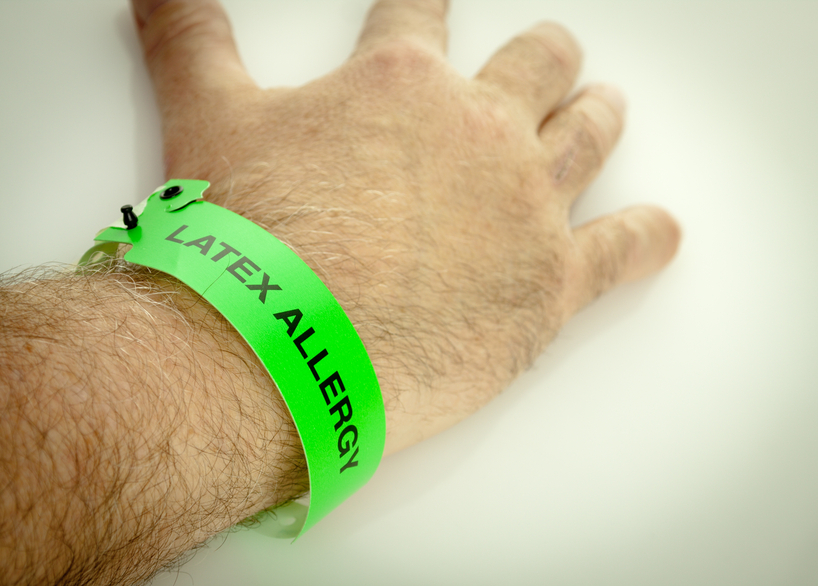Latex Allergy Management
Latex Allergy
Latex Allergy Overview
 Latex is a milky sap produced by rubber trees. The sap is blended with chemicals during manufacturing to give latex its elastic quality. Natural rubber latex is often found in rubber gloves, condoms, balloons, rubber bands, erasers and toys. If you are allergic to latex your body treats latex as an allergen and sets off an allergic reaction. Latex allergies are most common in people who have regular exposure to latex products such as rubber gloves. That is why this allergy is most common among healthcare workers and people who have undergone multiple surgeries.
Latex is a milky sap produced by rubber trees. The sap is blended with chemicals during manufacturing to give latex its elastic quality. Natural rubber latex is often found in rubber gloves, condoms, balloons, rubber bands, erasers and toys. If you are allergic to latex your body treats latex as an allergen and sets off an allergic reaction. Latex allergies are most common in people who have regular exposure to latex products such as rubber gloves. That is why this allergy is most common among healthcare workers and people who have undergone multiple surgeries.
Approximately 50% of people with latex allergy have a history of another type of allergy. Certain fruits and vegetables, such as bananas, chestnuts, kiwi, avocado and tomato can cause allergic symptoms in some latex-sensitive individuals.
Allergic reactions to latex range from mild to very severe. Every year, there are hundreds of cases of anaphylaxis, a life-threatening allergic reaction, due to latex allergy. The severity of allergic reactions to latex can worsen with repeated exposure to the substance.
Given the potential for a very serious allergic reaction, proper diagnosis of latex allergy is important. An allergist / immunologist has specialized training and expertise to accurately diagnose your condition and provide relief for your symptoms.
Keep pace with the latest information and connect with others. Join us on Facebook and Twitter.
Latex Allergy Symptoms & Diagnosis
Symptoms
There are different types of reactions that can occur upon contact with latex:
Delayed-type Contact Dermatitis
This condition appears 12 to 36 hours after contact with a latex product. Symptoms may include:
- Red skin
- Scaly skin
- Itchy skin
This type of reaction is usually triggered by the added chemicals in the rubber. Symptoms may be very irritating but typically not life-threatening.
Immediate Allergic Reactions
These reactions occur in people who have been previously exposed to latex and have become sensitized to the allergen which triggers the immune system to respond. With re-exposure to latex, symptoms may include:
- Sneezing or runny nose
- Coughing or wheezing
- Itchy throat
- Itchy, watery eyes
In the most serious allergic reaction, symptoms occur within minutes and involve multiple systems in the body. This life threatening condition is called anaphylaxis (an-a-fi-LAK-sis).
Symptoms of anaphylaxis typically involve more than one part of the body and may include:
- Red rash (usually itchy and may have welts/hives)
- Swollen throat or swollen areas of the body
- Wheezing
- Passing out
- Chest tightness
- Trouble breathing
- Hoarse voice
- Trouble swallowing
- Vomiting
- Diarrhea
- Stomach cramping
- Pale or red color to the face and body
Diagnosis
If you think you might be allergic to latex, visit an allergist / immunologist to diagnosis your symptoms. Your allergist will take a thorough health history and then use tests to determine if you have allergies. Skin tests or blood tests are the most common methods for determining your triggers.
Latex Allergy Treatment & Management
The only way to prevent an allergic reaction to latex is to avoid the substance. A new, natural rubber latex from the desert plant guayule is now being used for many products. This product is thought to be a safer alternative for people with latex allergy and healthcare workers.
Synthetic products are also safe. Substitutes for latex gloves, such as vinyl or nitrile gloves, should be used at all times by people with latex allergy.
Natural skin condoms are available, but while they protect against pregnancy, they do not shield against HIV or other sexually-transmitted diseases.
If you have mild skin reactions from latex, anti-inflammatory medications may help relieve symptoms.
People at risk of a serious, anaphylactic reaction to latex should carry autoinjectible epinephrine everywhere in case of emergency. Be sure to seek medial attention immediately in the event of a serious reaction.
The American Latex Allergy Association provides support to individuals who have been diagnosed with latex allergy.
Look to the experts
The AAAAI's Find an Allergist / Immunologist service is a trusted resource to help you find a specialist close to home.
Source: AAAAI




